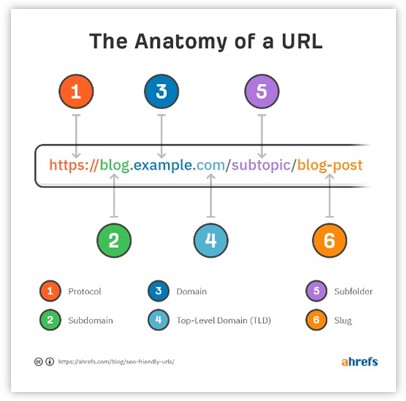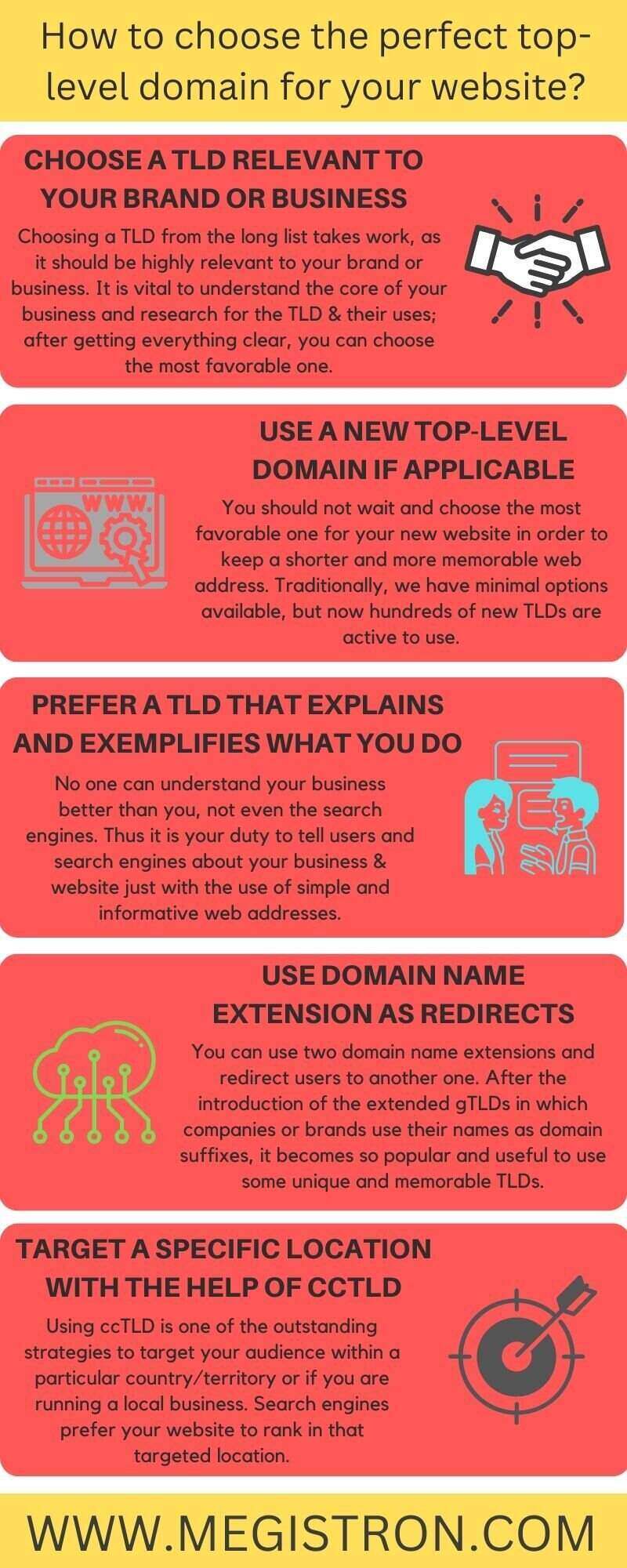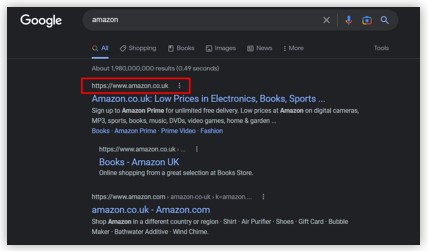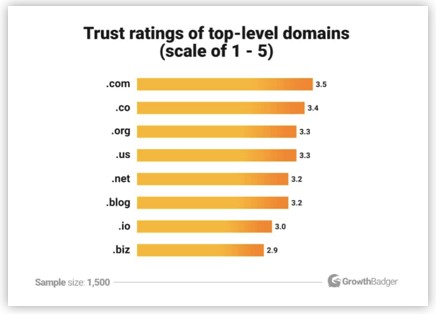The initial step while creating a website is choosing the best domain name for your website that suits and describes your business or brand. It is crucial as it becomes your identity in the online world, where there are roughly 50 billion web pages on 1.93 billion websites. One more term you must take care of while choosing your website domain is the Top-level domain, TLD.
Many website owners are amazed at how TLD has become so important, as most of them choose .com as their top-level domain and jump to the next step. The digital world has seen many changes since its early days, when there were very few options for domain endings available like .com, .org, .net, that’s all. In the online world, you can now choose from hundreds of domain endings that may be more meaningful and descriptive, making it easier for users to remember your website. You should consider many factors while choosing the appropriate top-level domain for your website, which we will discuss in this blog. Simultaneously, we will dive deeper into its definition, different types of TLD, top-level domain list, benefits of choosing the suitable TLD, and does it have any effect on the SEO of the website or not.
What is the top-level domain?
A top-level domain, TLD, also called domain name extension or domain suffix, is the part of the domain name that comes immediately after a dot (.); it tells the category of the websites on the internet. For example, the most common domain suffix in the top-level domain list is .com. It stands for commercial and is used by commercial businesses, blogs, or professional websites; .net means network. This is used majorly by websites specializing in network-based technology, database providers, and ISPs; .org stands for organizations and is used by nonprofits, social causes, groups, and clubs; .gov for governmental agencies, etc. Apart from these, other TLDs are .co, .io, .us, .info, .site, .tech, and many more. In the URL below, you can easily identify the last part, .com, after the Megistron, which is the top-level domain of this website.
While developing your website, it is crucial to maintain an SEO-friendly URL structure, as a semantically accurate URL has many benefits in ranking your website across SERPs. For this, you need to clearly understand each part of the URL, from choosing the perfect website domain to selecting the correct TLD from the top-level domain list is vital to make your URL semantically accurate. Before diving into the details of the TLD and its types, let’s try to identify the different parts of the website URL and understand its correct structure, which Ahrefs has already done for us.
What are the different types of top-level domains?
The Internet Assigned Numbers Authority (or the IANA) categorizes the top-level domain list into three types. These are gTLD, sTLD, and ccTLD. Let’s have a closer look at them one by one:
- Generic Top-Level Domain (gLTD) – According to the IANA database, there are 1, 200 TLDs that are generic. Most of the TLDs you see on the websites fall in this category, and most of them can be used by anyone. Commercial, organizational, informational, and network websites use .com, .org, .info, and .net. However, from 2011 companies or brands are allowed to register their names as the gTLD domain extension like .google, .amazon, .apple, etc. Some other examples of other gTLDs are .co, .xyz, .biz, etc.
- Sponsored Top-Level Domain (sTLD) – STLDs are sponsored by specific entities like businesses, governments, educational websites, etc. You need to fulfill some criteria to register domain name extensions for sTLDs thus cannot be used by anyone and are considered as trustworthy than any other TLD categories. These are generally the official websites of governments, education institutions, the military, travel, etc. The sponsored top-level domain lists only consist of 14 extensions to use in this category, thus making it safer than any other. Some common examples of sTLDs are .gov, .edu, .mil, .int, .coop, .museum, .jobs, .travel, etc.
- Country Code Top-Level Domain (ccTLD) – As its name indicates, it is the country code top-level domain. It means around 300 TLDs are reserved for countries, sovereign states, and territories. These are the two-character-long website domain name extensions representing the country’s name. Such as .ca for Canada, .br for Brazil, .fr for France, .in for India, .uk for the United Kingdom, .us for the United States, etc. Businesses use ccTLDs for geotargeting users as it enhances your visibility in the specific location, making it a useful strategy to target users in a special geographical area.
Traditionally, there are very few options available for website domain and hosting. With the increase in the number of websites and technology, numerous options are available, and the same applies to the top-level domains. Anyone can easily identify the type of website just by looking at the TLDs, and that’s the reason TLDs were introduced. You can get a full top-level domain list and the prices offered by Google domain here.
How to choose the perfect top-level domain for your website?
Choosing the perfect TLD for your website is crucial as it helps you in search engine optimization, gaining click-through rate, and enhancing visibility across search engine results pages. The website domain is the brand’s representation, while the top-level domain shows the website’s purpose and helps search engines categorize the websites on the internet. The decision about your domain name and TLD is very specific to you and your business goals. Thus, you should be very careful while choosing them. Below are some points that help you select the perfect domain extension for your website.
- Choose a TLD relevant to your brand or business – Choosing a TLD from the long list takes work, as it should be highly relevant to your brand or business. For example, if you have an informational website on which you are writing blogs, it makes no sense to use .org as your domain suffix. It only confuses the users and reduces the trustworthiness of your website, thus reducing the number of clicks and hence affecting your ranking on the search results page. It is vital to understand the core of your business and research the TLD & their uses; after clarifying everything, you can choose the most favorable one. You can also refer to your competitors or hire a digital marketing company for web design & development services.
- Use a new top-level domain if applicable – As we have discussed above, traditionally, we have minimal options available, but now hundreds of new TLDs are active to use. You should not wait and choose the most favorable one for your new website in order to keep a shorter and more memorable web address. One question suggested by Google should be asked every time while creating a website URL – Will your domain name as a whole be distinct and memorable? If the answer is Yes, you can go for it, but if you have any doubt, you can consider using a different top-level domain to make it unique and outstanding.
- Prefer a TLD that explains and exemplifies what you do – No one can understand your business better than you. Thus, it is your duty to tell users and search engines about your business & website with simple and informative web addresses. In the example above in which you were writing blogs on the website, use .info as their TLD so that anyone can easily understand that this website is providing information. Thus your website domain and content should perfectly align, and that’s what you need to do for a perfect web address.
- Use domain name extension as redirects – Yes, you heard it right! You can use two domain name extensions and redirect users from one to another. For example, if you go for search. Bing, it redirects to Bing.com. After the introduction of the extended gTLDs in which companies or brands use their names as domain suffixes, it becomes so popular and useful to use some unique and memorable TLDs. It has two benefits; one is that you can use some extraordinary TLD for your brand recognition, and second, you can also keep using the traditional top-level domain to gain the credibility and trust of the users.
- Target a specific location with the help of ccTLD – Using ccTLD is one of the outstanding strategies to target your audience within a particular country/territory or if you are running a local business. Search engines prefer your website to rank in that targeted location; below is an example where you can see Amazon uses the ccTLD to target the users in the UK location. And if you have users across the globe, you can simply go for the generic TLDs.
When choosing the domain for your website, domain name availability is one of the common issues that website owners face. But you can use an alternative method to get your preferred domain. The first one is you can try to buy the domain from its current owner or use a suitable variation in the brand’s name. Second, if you are trying for .com and are unavailable, then it is recommended to lean towards .net, .co, or a practical ccTLD, if applicable.
What are some unique benefits of domain name extension?
Choosing the correct TLD from the top-level domain list is as important as selecting your website domain and hosting. How it affects your search engine optimization ranking will be discussed in the next section, but apart from this, there are many benefits of getting a suitable TLD for your business. The most important one is memorability; the users remember unique TLDs and search for them directly in combination with their domain name. It is one of the first things that users notice in the web address, thus helping create a powerful first impression if suitable TLD is used in the URL. Search engines regularly add new TLDs that quickly communicate the purpose and offerings with the users and thus help your business’s branding.
Smartly used top-level domains can shorten your web address and can be easily available like if you want to use photographyideas.com, then you can also consider using ideas.photography would be short and catchy. Apart from these, many users perceive traditional URLs like .com, .net, etc. are more secure, credible, and trustworthy. If you want to shift to a new TLD, then you can use the redirects that take the user from the new URL to the old one; for example, you can redirect ideas.photography to photographyideas.com. This helps in brand protection by prohibiting others from buying the old domain. Also, you added freshness and uniqueness to your web address.
Does top-level domain affect your SEO?
The simple answer is no, as Google states, “Overall, our systems treat new gTLDs like other gTLDs (like .com and .org). Keywords in a TLD do not give any advantage or disadvantage in search”. Generally, gTLDs don’t matter with SEO ranking; also, any TLDs like .com are not given priority over others by search engines, but it can affect what people think about your brand or business and thus affects the number of clicks on the website. In the matter of trust, some TLDs are more reliable than others, as you can see in the data below.
Thus based on the public perceptions, credibility and trustworthiness the image above .com proved to be more significant than new TLDs. While country code Top-Level Domain (ccTLD) is helpful in geotargeting; it can rank high in the location for which it is geo-targeted.
Wrap up
Finally, we can conclude this blog by saying that you can choose any top-level domains available that should be highly relevant to your brand or business. It does not directly relate to the SEO ranking, but its importance is still high and something that draws the users’ attention. It is an integral part of the website’s URL structure and is a one-time setup; thus, you need to be smart while choosing it.
You can contact us as our SEO experts are always available to assist you with any type of SEO services, web design & development services, SEO plan & strategy services, etc.








